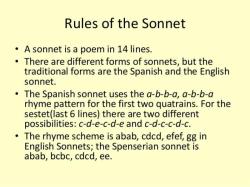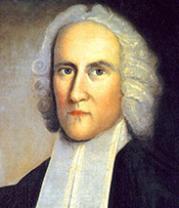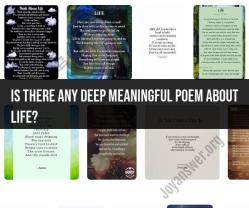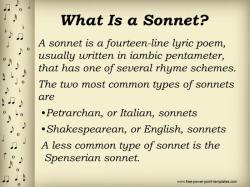What is true about Shakespearean sonnets?
Shakespearean sonnets, also known as English sonnets, are a form of poetry characterized by specific structural and thematic elements. Here are some characteristics that are true about Shakespearean sonnets:
Structure: Shakespearean sonnets consist of 14 lines written in iambic pentameter. They follow a specific rhyme scheme: ABABCDCDEFEFGG. This means that the first and third lines rhyme (A), as do the second and fourth lines (B), and so on, with the final couplet having a rhyming pattern of GG.
Three Quatrains and a Couplet: Shakespearean sonnets are divided into three quatrains (four-line stanzas) followed by a final couplet (two-line stanza). Each quatrain typically presents a different idea or argument related to the overall theme of the sonnet, while the couplet often provides a conclusion, resolution, or twist.
Volta: The sonnet usually contains a volta, or "turn," which occurs between the octave (the first eight lines) and the sestet (the final six lines). The volta marks a shift in tone, perspective, or argumentation within the poem.
Iambic Pentameter: Shakespearean sonnets are written in iambic pentameter, a metrical pattern consisting of five pairs of unstressed and stressed syllables per line. This rhythm creates a musical quality to the poetry and lends itself well to dramatic readings.
Themes: Common themes in Shakespearean sonnets include love, beauty, time, mortality, and the complexities of human relationships. Shakespeare often explores these themes through the lens of romantic or philosophical introspection.
Use of Imagery and Figurative Language: Shakespearean sonnets are known for their rich use of imagery, metaphor, and other figurative language devices. These poetic techniques help to evoke emotions, create vivid scenes, and convey complex ideas within the constraints of the sonnet form.
Sonnet Sequence: While individual Shakespearean sonnets can stand alone as individual poems, they are often part of a larger sequence or series of sonnets that collectively explore a central theme or narrative arc. One of Shakespeare's most famous sonnet sequences is "Sonnets" (1609), which comprises 154 sonnets.
These characteristics contribute to the enduring appeal and literary significance of Shakespearean sonnets, which continue to be studied, analyzed, and admired by readers and scholars around the world.
Defining Characteristics of Shakespearean Sonnets:
1. Structure:
- Three quatrains (four-line stanzas) and a final couplet (two lines): This creates a distinct 14-line structure with a clear shift in tone or focus between the three quatrains and the couplet.
- Iambic pentameter: Each line consists of five "iambs," which are unstressed syllable followed by a stressed syllable. This rhythmic pattern gives the sonnet a consistent, musical flow.
- ABAB CDCD EFEF GG rhyme scheme: Each quatrain uses a specific rhyming pattern, while the couplet has its own distinct rhyme. This rhyme scheme contributes to the structure and memorability of the sonnet.
2. Differences from Other Sonnet Forms:
- Italian (Petrarchan) Sonnets: Have two main sections: an octave (eight lines) followed by a sestet (six lines). The rhyme scheme and thematic shift often occur between these sections.
- Spenserian Sonnets: Similar to Shakespearean sonnets but use a different rhyme scheme (ABAB CDCD EFEF GG) and typically explore philosophical or allegorical themes.
3. Common Themes:
- Love: In various forms, ranging from idealized passion to unrequited love and loss.
- Beauty: Often associated with fleetingness and mortality.
- Time: The passage of time and its impact on beauty, love, and life.
- Mortality: The awareness of death and the search for meaning or remembrance.
- Mutability: The impermanence of things and the search for constancy.
Additional Notes:
- Shakespeare wrote 154 sonnets, exploring a wide range of themes and emotions within the structure of the Shakespearean sonnet.
- The sonnet form, particularly the Shakespearean variation, remains popular for its elegant structure and ability to convey complex emotions concisely.











